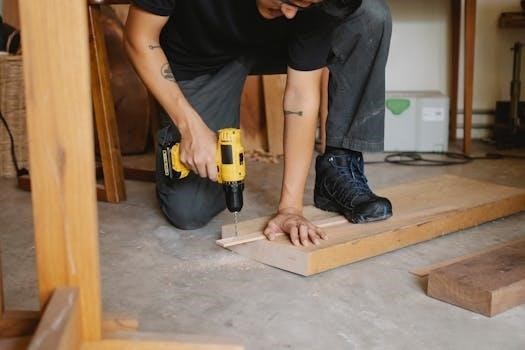
The Black & Decker All-In-One breadmaker offers a convenient way to enjoy homemade bread. This appliance simplifies baking with its automatic features, making it accessible to all users.
Overview of Black & Decker Breadmaker Models
Black & Decker offers various breadmaker models, including the All-In-One Deluxe, All-In-One Horizontal B2000, and B2200. These models feature different designs and functionalities, catering to diverse user preferences. Some models, like the B2200, are noted for their compact design and easy-to-clean components, while others, such as the Deluxe, emphasize automatic convenience. Each model aims to simplify the bread-making process, providing a user-friendly experience. The manuals for these models offer specific instructions tailored to their features and functions.
Getting Started with Your Breadmaker
Before using your breadmaker, it is crucial to wash all components. This initial cleaning removes any residue from manufacturing, ensuring optimal performance and taste.
Initial Setup and Cleaning
Prior to your first use, thoroughly wash all removable parts of your Black & Decker breadmaker. This includes the bread pan, kneading paddle, and any measuring cups or spoons provided. Use warm, soapy water and a soft cloth or sponge. Rinse all components well and ensure they are completely dry before assembly. This step removes manufacturing residues and ensures a clean start to your bread-making experience, eliminating any unwanted tastes.
Understanding the Control Panel and Settings
The Black & Decker breadmaker features an intuitive control panel. Familiarize yourself with the various buttons, including the menu selection for different bread types like white, whole wheat, and dough. Locate the crust darkness setting, if available, to adjust the color of your bread. The start/stop button initiates or cancels the baking process. A digital display shows the selected program, time remaining, and sometimes, crust settings. Understanding these controls will ensure successful bread making.

Basic Bread Making Process
Making bread involves adding ingredients correctly, selecting the right program on your Black & Decker, and starting the cycle. The machine does the rest, from kneading to baking.
Adding Ingredients in the Correct Order
For optimal results with your Black & Decker breadmaker, always add ingredients in the sequence specified by your recipe. Typically, liquids go first, followed by dry ingredients, and finally, yeast. Make a small indentation in the dry ingredients for the yeast, ensuring it does not come into direct contact with the liquid. This order prevents premature activation of the yeast, which could affect the rise of your bread. Precise measurements are also crucial.
Selecting the Right Program for Your Bread
The Black & Decker breadmaker offers various pre-programmed settings to suit different bread types. Choose the appropriate program based on your recipe; for example, white bread, whole wheat, or French bread. The correct program ensures proper mixing, kneading, rising, and baking times. Selecting the wrong program could lead to issues like an improperly baked loaf or a dough that doesn’t rise correctly. Refer to your manual for detailed descriptions of each program and its intended use.

Troubleshooting Common Issues
Encountering problems with your breadmaker is common. This section addresses typical issues such as bread not rising, crust problems, or kneading malfunctions, offering solutions for each.
Bread Not Rising Properly
If your bread isn’t rising, first ensure your yeast is fresh and not expired. Check that the liquid temperature is correct, typically between 105-115°F (40-46°C), for proper yeast activation. Precise ingredient measurement, especially flour, is crucial for the right dough consistency. Inadequate yeast or incorrect liquid temperature can hinder the rising process. Make sure to add the yeast last, and ensure it doesn’t come in direct contact with the liquid.
Crust Too Thick or Too Light
A crust that’s too thick often indicates that too much flour was used or the flour is old. Conversely, a too-light crust might mean the recipe wasn’t followed correctly. Some models have adjustable crust settings; explore your control panel for options. For models without adjustments, follow recipes carefully. Consider an egg wash before baking to influence crust darkness. Avoid opening the lid during baking to maintain temperature.
Paddle Not Kneading
If the paddle isn’t kneading, ensure it’s correctly attached to the shaft. The flat side of the hole in the paddle should align with the flat side of the shaft. Push it firmly into place. Check that the bread pan is properly inserted into the bread maker. Also, verify that your chosen program is suitable, as some have specific requirements. If one paddle is moving but the other is not, this may indicate a mechanical issue, or an issue with the machine itself.

Advanced Features and Recipes
Explore the dough setting for versatile baking options, and discover gluten-free recipes tailored for the breadmaker. These features expand your baking capabilities beyond basic loaves.
Using the Dough Setting
The dough setting on your Black & Decker breadmaker is a versatile tool for creating more than just loaves. It allows you to prepare dough for pizza, rolls, and other baked goods. When using this setting, ensure that the kneading paddle is correctly attached, as one paddle may not move properly, hindering the dough formation. Monitor the dough consistency; if it’s too tough, consider adding a small amount of water, particularly in recipes that don’t specify it. Proper ingredient measurements are vital for successful dough creation.
Exploring Gluten-Free Options
The Black & Decker breadmaker can accommodate gluten-free baking, but it’s essential to use recipes specifically designed for bread machines. Gluten-free flours behave differently than traditional wheat flour, requiring different ingredient ratios and techniques. These recipes will often call for a mix of gluten-free flours and additional binding agents. Ensure you measure ingredients accurately, as this is crucial for the proper rise and texture of gluten-free bread. Following a tested recipe will yield the best results.
Maintenance and Care
Proper maintenance ensures the longevity of your breadmaker. Regularly cleaning the bread pan and components is crucial. Store the breadmaker in a cool, dry place when not in use.
Cleaning the Bread Pan and Components
To clean the bread pan, remove it from the breadmaker after it has cooled completely. Wash the pan and kneading paddle with warm, soapy water using a soft sponge. Avoid using abrasive cleaners or scouring pads, as these can damage the non-stick coating. Ensure all parts are thoroughly rinsed and completely dry before reassembling. The exterior of the breadmaker can be wiped down with a damp cloth. Never immerse the main unit in water.
Storage Tips
When storing your Black & Decker breadmaker, ensure it is clean and completely dry to prevent any mold or mildew growth. Store the bread pan and kneading paddle inside the breadmaker, or separately if space is a concern. It is best to keep the breadmaker in a cool, dry place, away from direct sunlight and moisture. If you have the original box, that is ideal, otherwise choose a cabinet or pantry where it will not be subjected to accidental damage or dust accumulation.

Frequently Asked Questions
This section addresses common queries about the Black & Decker breadmaker. Find answers to issues from basic operation to troubleshooting, enhancing your baking experience.
Common Questions and Answers
Many users wonder why their bread isn’t rising, often due to old yeast or incorrect measurements. Another frequent question involves crust thickness, which can be adjusted or influenced by flour type. Issues with kneading are typically caused by improper paddle attachment or incorrect ingredient order. Always ensure fresh yeast and precise measurements for optimal results. Consult the manual for detailed troubleshooting.
Where to Find Manuals and Support
User manuals are often available online on the official Black & Decker website, or through various appliance manual databases. Additional support can be found via their customer service.
Accessing User Manuals Online
Finding your Black & Decker breadmaker manual online is straightforward. Start by visiting the official Black & Decker website, where they often host a digital library of product manuals. Alternatively, many third-party websites specialize in compiling appliance manuals, allowing you to search by model number. These online resources provide readily downloadable PDF files, offering easy access to operating instructions, troubleshooting tips, and recipe guides; Ensure you download the correct manual by verifying the exact model number of your breadmaker.
Seeking Additional Help
If you’re encountering issues not covered in the manual, several options are available for additional support. Black & Decker’s customer service is a primary resource, offering assistance via phone, email, or their website’s support portal. Online forums and communities dedicated to breadmakers can also be valuable, allowing you to interact with other users who may have experienced similar challenges. Local appliance repair shops could provide hands-on help for complex issues if necessary. Remember to have your model number handy when seeking support.